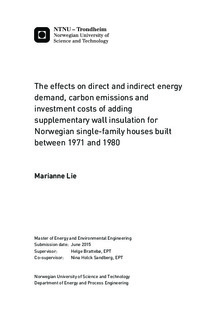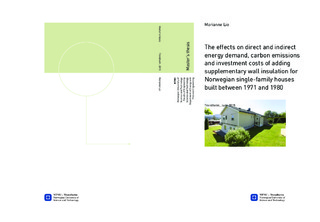| dc.description.abstract | In this report, I analyze the energy savings and carbon reduction potential of Norwegian
single-family houses constructed between 1971 and 1980 (SFH03) when adding supplementary insulation to the outer walls. The report is split into two parts, where the first part consists of a material analysis and an energy audit for different façade refurbishments of a SFH03 building. The second part covers a scenario analysis of the different insulation solutions when modeling the SFH03 building stock segment in a dynamic building stock model from the year 2000 to 2050. Each insulation solution represents a unique renovation state in the SFH03 housing stock, with an associated annual heating demand calculated from the energy audit. In addition, renovation cycles, hence the time period between façade refurbishments, of 30, 40 and 50 years have been applied.
Vacuum insulation and mineral wool insulation are the two insulation types analyzed in the material analysis. However, mineral wool insulation is found to be a better material for façade refurbishment due to lower investment costs, lower indirect emissions and energy usage during manufacturing and a higher lifetime. Manufacturing vacuum insulation results in nine times more energy consumption and seven times more carbon emissions compared to manufacturing mineral wool corresponding to the same insulation solution.
The three different façade refurbishments assessed in the energy audit are, starting from the least ambitious refurbishment, historically refurbished state, approaching TEK 10 requirements and approaching passive house requirements. The annual energy need for heating for a chosen SFH03 building in original state amounts to 152 kWh/m2. A façade refurbishment will result in significant energy savings, corresponding to the heating demand for the different renovation refurbishments of respectively 14, 24 and 30 kWh/m2 for mineral wool insulation. Applying vacuum insulation will result in slightly lower energy savings, with a difference of respectively 1 kWh/m2 for TEK 10 standard and 2 kWh/m2 for passive house standard.
The objective of the report is to investigate the reduction potential of energy consumption and carbon emissions for the SFH03 dwelling stock segment towards 2050 when introducing more advanced insulation solutions for façade refurbishments. For the baseline scenario, the energy reduction potential in 2050 is almost 1/3 relative to 2010 for all renovation cycles. The baseline scenario corresponds to a scenario with an unchanged refurbishment policy, where historical façade refurbishment is conducted throughout the whole simulation period. All other scenarios, where more advanced insulation solutions are applied, will result in an even lower future heating demand. The carbon emission reduction potential is equal to the energy potential and achieves the same reduction in percentage as the energy consumption, hence 1/3 for the baseline scenario and lower for the remaining renovation solutions. The reduction potential is highly due to a larger share of demolished SFH03 dwellings in 2050.
Single-family houses accounts for almost 70 % of the Norwegian residential stock in 2012. The SFH03 stock segment accounts for about 13 % of these. By introducing a more ambitious renovation strategy of façade refurbishment for ageing single-family houses, this will contribute to reaching climate policy targets and achieving a significant reduction in energy usage and carbon emissions. | |

